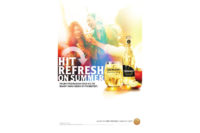Although it accounts for only a small portion of the overall beer category, hard cider is finding a home with American consumers. “Compared to beer, cider tends to be more gender neutral, and I think there continues to be growth opportunities with females for cider,” says Danelle Kosmal, vice president of the beverage alcohol practice at New York-based Nielsen. “Additionally, the hard cider drinker tends to be the younger and more affluent legal-drinking-age consumers, similar to the craft drinker.”
Those growth opportunities are evident, with the segment experiencing $400 million in dollar sales for 2014, up 75.4 percent from 2013 in Nielsen-measured channels, Kosmal says. “While still small relative to the overall malt-based/cider category — cider represents 1.2 percent of total category dollars — cider has grown tremendously the past several years, and we expect to see continued growth,” she explains. “Not only is the segment attracting more dollars, but it is also attracting more consumers. In the U.S., 4.5 percent of households purchase hard cider, which is up from 2.9 percent the previous year.”
Jeff Nowicki, chief strategy officer with Bump Williams Consulting (BWC), Stratford, Conn., notes that hard cider resembles the infancy stage of craft beer from the early 1980s. “Over the past four years, SKUs have increased over 100 percent,” he says. “Local cideries have appeared across the country, and the segment has been almost doubling its share of the category sales year after year.”
Beth Bloom, food and drink analyst for Chicago-based Mintel, notes that volume sales for hard cider increased 278 percent from 2010 to 2014 and credits the segment’s innovation for this growth. “A lot of that has to do with the release of new products,” she says. “A lot of big brands have put some energy in releasing products that fall into that category. Also, we’ve seen over the past few years a growing sweet tooth, and we saw trends in flavors and alcohol and sweeter wines like Moscato. That’s kind of making the beer market a little bit more accessible [by offering] some sweeter flavors, which appeals to younger consumers like a point of entry into a new market.”
Among those innovations are different fruits and flavors. For instance, hard cider brands are experimenting with pear, ginger, cinnamon and other seasonal flavors, Nielsen’s Kosmal says. BWC’s Nowicki adds that elderflower and cherry have been used in conjunction with apples. However, he notes that the top-selling brands still use a mixture of apple varieties and styles.
Hard cider also is helping to expand the overall alcohol space. “Less than half of cider volume is coming from existing brands in beer, wine or spirits,” Nielsen’s Kosmal says. “On the other hand, just over half of cider volume is coming from new category buyers, or from buyers that have increased their overall purchasing; adding cider to their beer, [flavored malt beverage], wine and spirits purchases.”
Brands also are investing in marketing hard cider to the masses. Strongbow, a brand of White Plains, N.Y.-based Heineken USA, launched its Cider at its Bestest campaign where it sought to communicate to consumers that the brand is best served over ice and utilizes a TV spot titled “Slow Motion Horse” to convey that. In March 2014, the brand re-launched with new flavors Gold Apple and Honey & Apple. According to IRI data, Strongbow dollar sales increased 88 percent with case sales up nearly 105 percent in the 52 weeks ending Dec. 28, 2014.
The hard cider category also saw major brewers enter the market in 2014. St. Louis-based Anheuser-Busch, a division of Anheuser-Busch InBev, released its first wholly new brand in eight years: Johnny Appleseed Hard Apple Cider.
BWC’s Nowicki notes that because hard cider has not reached mainstream status, he anticipates that the segment will continue to grow and smaller brands still will be able to compete within the marketplace. “Much like craft, I think the hands-on experience offered by local cider producers will benefit small-cottage industry development that will continue for many years to come,” he says.








